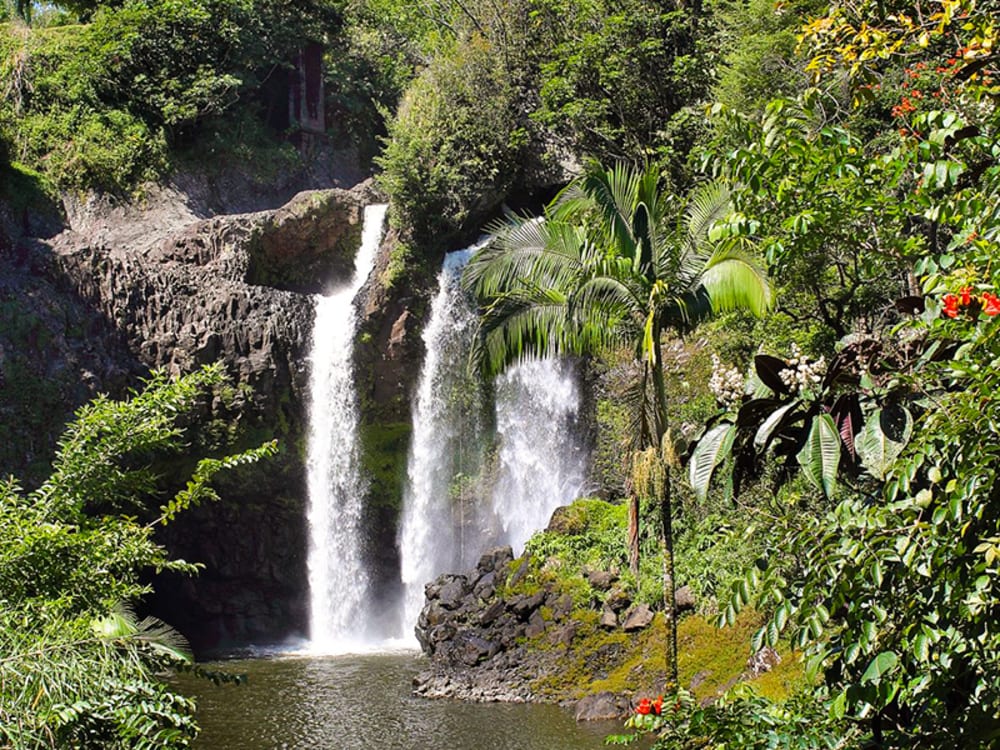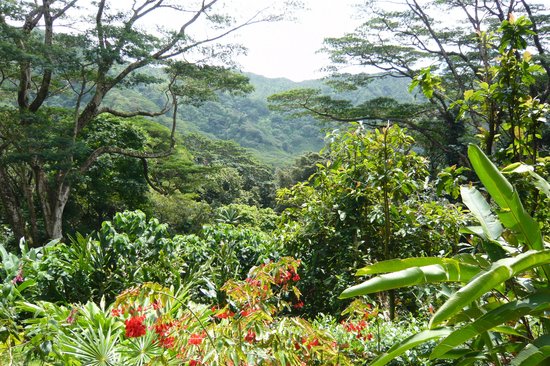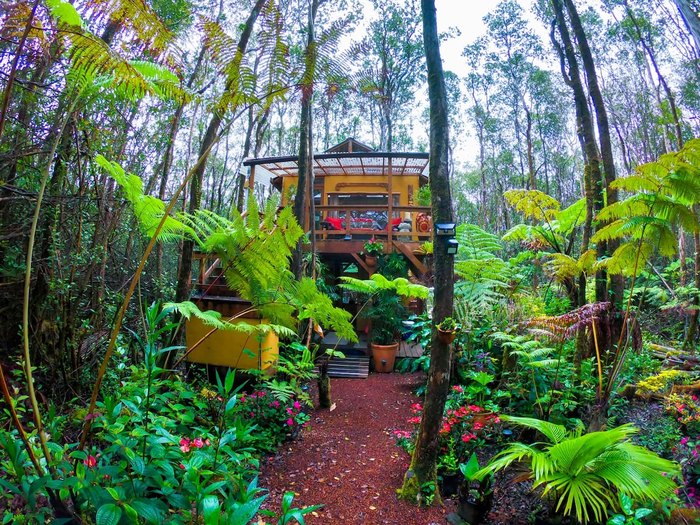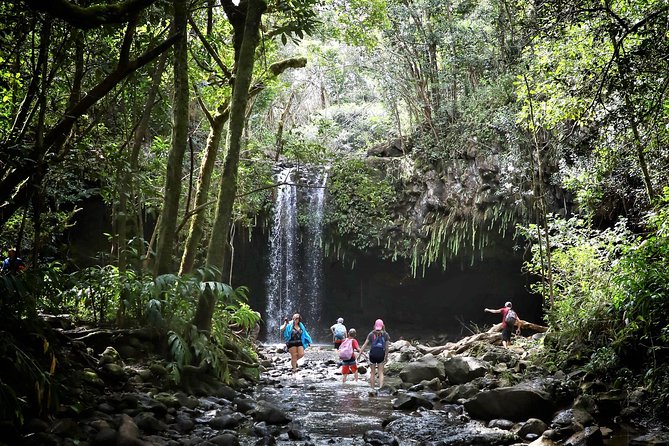You are about to embark on a remarkable journey through the enchanting rainforests of Hawaii. With their vibrant colors, exotic wildlife, and lush vegetation, these rainforests are truly a sight to behold. In this article, you will discover various ways to immerse yourself in the captivating beauty of Hawaii’s rainforests, from hiking through dense trails to taking a leisurely stroll amidst breathtaking waterfalls. So grab your sense of adventure and get ready to explore the hidden gems nestled within these verdant landscapes.

Best Time to Visit Hawaii’s Rainforests
Weather Considerations
When planning your visit to Hawaii’s rainforests, it’s crucial to consider the weather. The islands have a tropical climate, which means you can expect warm temperatures and high humidity year-round. However, the rainforests receive more rainfall compared to other regions of Hawaii. The wettest months are usually from November to March, so if you don’t mind the occasional downpour, visiting during this time can be a great way to experience the vibrant greenery and lush landscapes in their full splendor.
Off-peak Season for Lower Crowds
If you prefer to explore the rainforests with fewer crowds, visiting during the off-peak season is your best bet. The months of April to October are the shoulder seasons, offering a less crowded experience while still providing favorable weather conditions. This is an excellent time to immerse yourself in the tranquility of the rainforest, enjoying the sounds of chirping birds and the swaying of tall trees without the hustle and bustle of peak tourist season.
Wildlife Viewing Opportunities
Hawaii’s rainforests are home to a rich variety of wildlife, making them a haven for nature enthusiasts. From colorful birds to unique insects and small mammals, there is no shortage of fascinating creatures to observe. If wildlife viewing is high on your list of priorities, timing your visit during the early morning or late afternoon might give you a better chance of spotting these beautiful creatures as they tend to be more active during these times. Be sure to bring your binoculars and a camera to capture these incredible moments.
Choosing the Right Rainforest to Explore
Types of Rainforests in Hawaii
Hawaii is home to two main types of rainforests: the lowland rainforests and the montane rainforests. The lowland rainforests, located at lower elevations, are characterized by dense vegetation, towering trees, and a warm, humid climate. On the other hand, the montane rainforests can be found at higher elevations, and they exhibit a cooler and more misty atmosphere. Each type of rainforest offers a unique experience, so consider your preferences and interests when choosing which one to explore.
Popular Rainforest Destinations
When it comes to popular rainforest destinations in Hawaii, there are several exceptional options to choose from. The Hana Rainforest in Maui boasts breathtaking waterfalls, lush green valleys, and the famous Road to Hana, offering an unforgettable journey through dense vegetation. Another popular destination is the Akaka Falls State Park on the Big Island, where you can marvel at the towering Akaka Falls and hike through a lush rainforest-filled trail. Lastly, Koke’e State Park in Kauai offers stunning vistas, diverse plant life, and extensive hiking opportunities that cater to all skill levels.
Accessibility Factors
Accessibility is an essential factor to consider when choosing a rainforest to explore in Hawaii. Some rainforests require a moderate level of physical fitness and hiking ability due to their rugged terrain and steep trails. If you have mobility concerns or prefer easier access, there are rainforests like Waimea Canyon State Park in Kauai that provide more accessible viewpoints and well-maintained trails. It’s important to assess your physical capabilities and choose a rainforest that aligns with your comfort level to ensure an enjoyable experience.
Explore Uncharted Hawaiian Destinations
Planning Your Rainforest Adventure
Research and Preparations
Before embarking on your rainforest adventure in Hawaii, conducting thorough research is essential. Familiarize yourself with the specific rainforest you plan to visit, including its features, hiking trails, and any potential safety concerns. Learn about the flora and fauna you may encounter to enhance your overall experience. Additionally, check the latest weather forecasts and plan accordingly by packing appropriate clothing, gear, and necessities such as insect repellent, sunscreen, and plenty of water. Being well-prepared will ensure that you can fully enjoy and appreciate the beauty of Hawaii’s rainforests.
Booking Accommodations
When planning your trip to Hawaii’s rainforests, it’s crucial to consider your accommodations carefully. Depending on the location of the rainforest you intend to explore, there may be hotels or lodges nearby that offer convenient access. Alternatively, you might prefer to stay in a resort that provides guided rainforest tours or transportation options. If you prefer a more immersive experience, there are also campgrounds available where you can spend the night surrounded by nature. Regardless of your preference, booking your accommodations in advance will ensure a stress-free and comfortable stay.
Transportation Options
Navigating the Hawaiian islands to reach your rainforest destination requires careful consideration of transportation options. Renting a car is a popular choice for visitors as it provides flexibility and convenience, allowing you to explore at your own pace. However, some rainforests may have limited parking or require four-wheel-drive vehicles, so be sure to research the specific requirements beforehand. Alternatively, guided tours often provide transportation to and from rainforest locations, which can be advantageous if you prefer not to drive or want the expertise of a knowledgeable guide. Public transportation options, such as buses or shuttles, may also be available depending on the island and rainforest you plan to visit.
Guided Tours vs. Independent Exploration
Benefits of Guided Tours
Opting for a guided tour offers numerous benefits when exploring Hawaii’s rainforests. Knowledgeable guides can provide valuable insights into the rainforest’s ecosystem, its history, and the unique plants and animals you may encounter. They can guide you to the best viewpoints, ensuring you don’t miss any hidden gems. Guided tours also often include transportation, eliminating the need for you to navigate unfamiliar roads or worry about parking. Additionally, safety is enhanced as guides are trained to handle any emergencies that may arise in the rainforest.
Self-Guided Adventure Tips
If you prefer a more independent and flexible experience, self-guided exploration of the rainforests might be the way to go. Before setting off, make sure you have a detailed map or guidebook that outlines the trails and points of interest. Research the necessary permits and regulations, especially for more remote or protected areas. It’s important to stay on designated trails, respect any posted signs, and adhere to safety guidelines to minimize your impact on the environment and ensure your own well-being. Bring snacks, water, and any necessary equipment such as hiking boots, rain gear, and a first aid kit. With proper planning and knowledge, self-guided exploration can provide a rewarding and personalized rainforest adventure.
Respecting Nature and Culture
Whether you choose a guided tour or self-guided exploration, it’s crucial to prioritize respect for both nature and the local culture. Hawaii’s rainforests are not only ecologically significant but also hold cultural and historical importance for the indigenous Hawaiian people. Follow Leave No Trace principles by leaving the rainforest as you found it, disposing of waste properly, and refraining from removing or damaging any natural or cultural resources. Be mindful of the plants and animals you encounter, keeping a respectful distance and refraining from feeding or touching them. Lastly, educate yourself about the local culture, traditions, and protocols, and follow them respectfully during your visit.

Plan Your Dream Hawaiian Getaway
Rainforest Hiking Trails and Safety
Top Hiking Trails in Hawaii
Hawaii offers an array of magnificent hiking trails within its rainforests, catering to all skill levels and preferences. Some notable trails include the Kalalau Trail in Kauai, a challenging and breathtakingly scenic trail that traverses along the dramatic Na Pali Coast. For a less strenuous option, the Waihee Ridge Trail in Maui provides stunning panoramic views of lush valleys and the coastline. On the Big Island, the Kilauea Iki Trail takes you through volcanic landscapes and lush rainforest, offering a unique combination of natural wonders. Regardless of the trail you choose, be prepared for varying conditions, including slippery terrain, sudden weather changes, and limited or no cell phone reception.
Trail Difficulty and Length
Understanding the difficulty level and length of the hiking trails is essential to ensure a safe and enjoyable experience in Hawaii’s rainforests. Many trails are categorized as easy to moderate, suitable for beginners and families. These trails typically cover shorter distances and have well-maintained paths. However, some trails, such as the more challenging ones in remote areas, may be longer and involve steeper ascents or descents. Assess your fitness level and select trails that align with your capabilities. It’s always advisable to start with shorter and less strenuous hikes to acclimate to the terrain and weather conditions before attempting more challenging trails.
Safety Precautions and Gear
Safety should be a top priority when hiking in Hawaii’s rainforests. Start by checking the weather forecast and trail conditions before heading out. Tropical rainforests can have unpredictable weather patterns, so prepare for sudden rain showers by bringing a waterproof jacket or poncho. Wear sturdy and comfortable hiking shoes with good traction, as the terrain can be slippery and uneven. It’s also crucial to bring a backpack with essentials such as a trail map, compass or GPS device, plenty of water, snacks, a first aid kit, and insect repellent. Additionally, inform someone of your hiking plans and expected return time to ensure your safety.
Experiencing Hawaiian Flora and Fauna
Unique Plant Species
Hawaii’s rainforests are a treasure trove of unique and diverse plant species, many of which are endemic to the islands. From the majestic Ohia Lehua trees with their vibrant red blossoms to the delicate ferns and mosses that cover the forest floor, you’ll be surrounded by a botanical wonderland. Keep an eye out for the colorful Anthurium flowers, fragrant white ginger, and towering tree ferns. If you’re lucky, you may even stumble upon the rare and endangered Haleakala silversword, a striking succulent that thrives in the volcanic slopes of Maui. Take your time to observe and appreciate the intricate details of these fascinating plants that contribute to the rainforest’s biodiversity.
Birdwatching Opportunities
Hawaii’s rainforests are also a haven for bird enthusiasts, offering the chance to spot unique avian species found nowhere else in the world. The vibrant and melodious Hawaiian honeycreepers, such as the ‘I’iwi, ‘Apapane, and ‘Amakihi, can be seen darting among the trees with their colorful plumage. The endangered Hawaiian Goose, or Nene, may graze near rivers or open areas within the rainforest. If you venture higher into the montane rainforests, listen for the calls of the native ‘Oma’o and ‘Elepaio. Binoculars and a field guide can enhance your birdwatching experience, allowing you to identify and appreciate the diverse avifauna of Hawaii.
Endangered and Protected Species
While exploring Hawaii’s rainforests, it’s important to be mindful of the endangered and protected species that call these forests home. The Hawaiian Monk Seal, Hawksbill Turtle, and Green Sea Turtle are some of the marine species that rely on the rainforest watersheds for their survival. On land, the Hawaiian Hoary Bat and the Hawaiian Happy Face Spider are just a few examples of the unique and fragile creatures that inhabit the rainforests. Respect their habitats by keeping a safe distance, refraining from touching or disturbing them, and supporting conservation efforts that aim to protect these vulnerable species for generations to come.

Experience Hawaii’s Unique Attractions
Waterfalls and Swimming Holes
Must-Visit Waterfalls
No visit to Hawaii’s rainforests would be complete without marveling at the stunning waterfalls that punctuate the landscape. Take a trip to the famous Wailua Falls in Kauai, where you can witness torrents of water cascading into a picturesque pool below. Akaka Falls on the Big Island is another must-see, with its dramatic 442-foot drop surrounded by verdant greenery. For a more secluded experience, venture to the Seven Sacred Pools, also known as Ohe’o Gulch, in Maui’s Haleakala National Park. These stunning tiered waterfalls offer refreshing swimming holes and breathtaking natural beauty. Remember to exercise caution when near waterfalls, as slippery rocks and fast-moving currents can be dangerous.
Swimming Safety Tips
While swimming in the rainforest’s crystal-clear pools can be a memorable experience, it’s vital to prioritize safety. Before entering the water, assess its depth and current. Avoid diving into unfamiliar pools, as hidden rocks or shallow sections can cause serious injury. If you’re not a confident swimmer, consider wearing a life jacket to provide extra buoyancy. Be wary of flash floods, especially during periods of heavy rain, as water levels can rise rapidly. Always supervise children closely and ensure they are wearing appropriate flotation devices. By exercising caution and respecting the power of nature, you can enjoy a refreshing and safe swimming experience.
Eco-friendly Practices
Preserving the natural beauty of Hawaii’s rainforests is crucial for the wellbeing of these delicate ecosystems. When visiting waterfalls and swimming holes, practice eco-friendly habits to minimize your impact on the environment. Avoid leaving any waste behind, including food wrappers, plastic bottles, or sunscreen bottles. Instead, bring a reusable water bottle and pack out your trash to help keep the rainforest pristine. Refrain from using soaps or shampoos in natural pools to prevent contamination of the water. Respect any signage or barriers that indicate protected areas or restricted access, as these are in place to safeguard the sensitive ecosystem. By adopting these eco-friendly practices, you can contribute to the long-term preservation of Hawaii’s rainforests.
Cultural and Historical Sites
Sacred Sites and Petroglyphs
Hawaii’s rainforests are not only rich in natural beauty but also steeped in cultural and historical significance. Throughout the islands, you may come across sacred sites and ancient petroglyphs that offer glimpses into the region’s past. These sites, including heiau (temples) and wahi pana (legendary sites), hold deep spiritual meaning for the indigenous Hawaiian people. When encountering these areas, it’s crucial to show utmost respect by refraining from touching or removing any stones or artifacts. Take the time to learn about the stories and traditions associated with these sites, and consider hiring a local guide who can provide deeper insights into their cultural significance.
Importance of Cultural Respect
As a visitor to Hawaii’s rainforests, it is essential to approach the local culture with respect and humility. The Hawaiian culture has a deep connection to the land and its natural resources, and it is vital to acknowledge and honor this relationship. Educate yourself about the customs, traditions, and protocols that are practiced in the rainforest areas. Ask permission before entering private lands or sacred sites, and be mindful of any cultural restrictions or taboos. By respecting the local culture, you not only contribute to the preservation of Hawaiian heritage but also create meaningful connections with the land and its people.
Learning from Local Guides
To gain a deeper understanding of the rainforests’ cultural and historical significance, consider engaging the services of a local guide. Local guides possess a wealth of knowledge passed down through generations, and their insights can provide valuable context to your rainforest visit. They can share stories about the mythology, legends, and traditional land management practices associated with the rainforests. Local guides can also help you navigate the trails, identify significant plant and animal species, and answer any questions you may have. Engaging with local guides not only enhances your own experience but also supports the local economy and helps preserve traditional knowledge for future generations.

Rainforest Photography Tips and Techniques
Capturing the Beauty of Rainforests
Hawaii’s rainforests are a photographer’s paradise, offering a multitude of stunning landscapes, vibrant colors, and unique flora and fauna to capture. To make the most of your rainforest photography, consider these tips and techniques. Utilize wide-angle lenses to capture the expansive rainforest vistas and highlight the dense vegetation. Experiment with different angles and compositions to convey a sense of depth and perspective. Macro lenses are perfect for capturing the intricate details of flowers, leaves, and insects. Take advantage of the soft, diffused light that filters through the canopy by shooting during the early morning or late afternoon. Lastly, be patient and observant, allowing nature to reveal its beauty to you.
Equipment and Gear Suggestions
Having the right equipment and gear is crucial for successful rainforest photography. Start with a sturdy tripod to ensure stability and sharpness, particularly when shooting in low-light conditions. A wide-angle lens, such as a 16-35mm or 10-18mm, is ideal for capturing the vastness of the rainforest. Consider a macro lens, such as a 100mm or 105mm, to photograph the intricate details of flora or smaller creatures. An optional telephoto lens can be useful for capturing distant wildlife or waterfalls. Don’t forget spare batteries, memory cards, and lens cleaning tools to ensure you’re always ready to capture that perfect shot. Lastly, protect your gear from the tropical elements with a rain cover or a waterproof camera bag.
Composition and Lighting Tips
Composition and lighting play a vital role in creating captivating rainforest photographs. Experiment with the rule of thirds by placing the main subject off-center, allowing the viewer’s eye to naturally explore the frame. Incorporate leading lines, such as winding paths or tree branches, to guide the viewer’s gaze deeper into the rainforest scene. Utilize the rainforest’s diverse layers, including the foreground, midground, and background, to add depth and dimension to your images. Pay attention to the quality of light, seeking soft and diffused light that filters through the foliage for a more flattering effect. Lastly, take advantage of the rainforest’s ever-changing weather and atmospheric conditions to create moody and dramatic photographs that evoke a sense of mystery and awe.
Preserving the Rainforests for Future Generations
Leave No Trace Principles
Preserving the fragile ecosystems of Hawaii’s rainforests is essential to ensure their survival for future generations. Embracing the Leave No Trace principles is crucial when exploring these natural wonders. Practice proper waste management by packing out all your trash, including food wrappers, bottles, and any other items. Leave the rainforest untouched by avoiding the removal of plants, rocks, or any other natural resources. Stay on designated trails to minimize your impact on the delicate vegetation and avoid trampling or damaging sensitive areas. Lastly, respect wildlife by observing from a distance and refraining from feeding or touching them. By following these principles, you contribute to the long-term conservation and enjoyment of the rainforests.
Supporting Conservation Efforts
If you’re passionate about preserving Hawaii’s rainforests, consider supporting local conservation efforts. Many organizations and initiatives are dedicated to protecting and restoring the rainforest ecosystems, ensuring their sustainability for future generations. Research and identify reputable conservation organizations that focus on rainforest preservation and consider donating to their cause. Participating in volunteer activities, such as tree planting or habitat restoration projects, can also be a rewarding way to contribute your time and effort to the conservation of the rainforests. By supporting these initiatives, you actively engage in the protection of Hawaii’s natural heritage.
Educating Others About Rainforest Conservation
One of the most impactful ways to contribute to rainforest conservation is by spreading awareness and educating others about the importance of these ecosystems. Share your experiences and knowledge with friends, family, and fellow travelers, inspiring them to appreciate and respect Hawaii’s rainforests. Utilize social media platforms, blogs, or personal interactions to highlight the unique beauty and significance of these environments. Encourage responsible travel practices and the adoption of sustainable behaviors that minimize the impact on the rainforests. By fostering a collective consciousness about rainforest conservation, you help ensure that these remarkable ecosystems continue to thrive and inspire generations to come.
In conclusion, exploring Hawaii’s rainforests offers an incredible opportunity to immerse yourself in nature’s beauty and experience the unique ecosystems that thrive in these verdant havens. With careful planning, respect for the environment and local culture, and an appreciation for the delicate balance of flora and fauna, you can have a memorable and fulfilling rainforest adventure. Whether you choose to embark on a guided tour or venture out independently, remember to capture the moments through photography while leaving no trace behind. By preserving and supporting the rainforests, you contribute to their preservation for future generations and pave the way for continued appreciation of their lush beauty.
